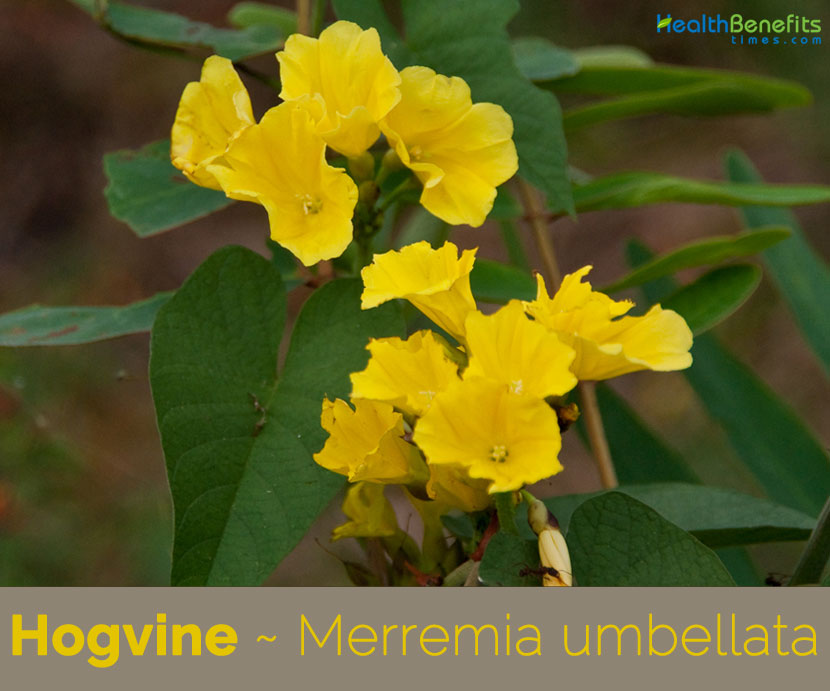| Hogvine Quick Facts | |
|---|---|
| Name: | Hogvine |
| Scientific Name: | Merremia umbellata |
| Origin | Tropical East Africa, Seychelles, India, Sri Lanka eastwards to China, Indo-China, Thailand, and southwards through Malesia to northern Australia |
| Shapes | Capsule ovoid to conical 10-15 mm long, splitting into four |
| Health benefits | Beneficial for rheumatism, headaches, burns, abscesses, ulcers, sores, scalds, dysentery, hematuria, malaria, smallpox |
Plant description
Hogvine is a twining, herbaceous, vigorous perennial climbing vine that may grows about 1-3 m tall. The plant is found growing in edges of forests, in grasslands, roadsides and waterways, clearings, deforested areas, vacant land in villages, mixed deciduous forest, evergreen hill forest, swamp margins, secondary scrub, thickets, hedges, along fields, in teak forests and on river-banks. The plant prefers well drained fertile soil.
Leaves
Leaves are ovate to oblong in shape, with a size of measuring about 4-16 cm long and 1-9 cm wide, cordate base and rounded or truncate in shape. The basal lobes are rounded or angular, acuminate apex where both sides are sparsely to densely hairy. Petiole is measuring about 1.5-6 cm long.
Flower
Cymes are few to many flowered, umbelliform, with measuring about 1-7 cm long peduncle, minute bracts and caduceus. Flower-buds are ovoid in shape, with a size of measuring about 5-9 mm long pedicel. Sepals are strongly concave, slightly unequal. Outer 2 sepals are broadly elliptic or nearly circular, 8–14 mm, abaxial surface pubescent, rounded or emarginated. Inner sepals are usually slightly longer, margin scarious. Corolla is white or yellow, funnel form, 2.5–5.5 cm, mid petaline bands with a strip of whitish pubescence apically; limb slightly lobed. Stamens included; anthers not twisted. Ovary is glabrous or sparsely pubescent apically. Flowering normally takes place from January—March and October—December.
Fertile flowers are followed by capsule that is ovoid to conical in shape, measuring about 10-12 mm long, mucronate by style-base and hairless or sparsely hairy at the top. Seeds are truncate apically, brown, 5-6 mm long, densely pubescent with short, erect trichomes. They are covered with spreading, black or brown hairs.
Traditional uses and benefits of Hogvine
- Pounded leaves are used as a poultice for wounds, burns and sores in Asia.
- Poultice of leaves mixed with curcuma powder is used to heal cracks in the soles of the feet.
- Infusion of young leaves is applied to clean wounds and ulcers.
- Roots are used as a laxative/purgative, and the flowers are used to treat eye diseases.
- Decoction of the plant is used as diuretic, and to treat rheumatism and headaches in India.
- Powder of leaves is sniffed to treat epilepsy, and a paste made of root powder mixed with “Java flour” (coffee flour) is applied to swellings.
- Mucilage obtained from the seeds soaked in water is used in cutaneous diseases.
- umbellata has been used to treat paralyses, spasms and convulsions in West Africa.
- This species has been used for fever in Palau.
- It is used also for dropping into the ear in cases of auricular ulcers, abscesses, etc.
- Dried, powdered leaves are sniffed up the nose as a treatment for epilepsy.
- Pounded leaves are used to poultice burns, abscesses, ulcers, sores and scalds.
- Poultice of the leaves, combined with Curcuma powder is applied on cracks on the hands and in the soles of the feet.
- Seeds, when soaked in water, yield mucilage that is used as an aperient and alterative in the treatment of cutaneous diseases in Bengal.
- Tubers are mildly laxative and are widely taken as a remedy for dysentery.
- Decoction of the roots is drunk as a remedy for hematuria.
- Paste or powder made of the root, often mixed with Java flour and water, is applied as a poultice to swellings.
- An infusion of the plant is drunk as a treatment for high fever.
- An infusion of the stem is used internally and externally in the treatment of malaria and smallpox.
- Root is eaten raw as a stomachic.
- Decoction of the plant is said to act as a deobstruent, a diuretic, and an alterative, being useful in rheumatism, neuralgia, headache, etc.
- It is used also for dropping into the ear in cases of auricular ulcers, abscesses, etc.
- Powder of the leaves is sniff up in epilepsy.
- Paste or powder made of the root, mixed with Java flour and water, is applied to swellings.
- Leaves are used in the Moluccas as an emollient for abscesses and ulcers.
References:
https://www.itis.gov/servlet/SingleRpt/SingleRpt?search_topic=TSN&search_value=30872#null
https://davesgarden.com/guides/pf/go/53227/
https://www.cabi.org/isc/datasheet/33477
https://plants.usda.gov/core/profile?symbol=MEUM
http://convolvulaceae.myspecies.info/node/16226
http://tropical.theferns.info/viewtropical.php?id=Merremia+vitifolia
http://www.stuartxchange.org/Kalamitmit
http://www.theplantlist.org/tpl/record/tro-8500797
https://en.wikipedia.org/wiki/Merremia_umbellata
http://www.flowersofindia.net/catalog/slides/Hogvine.html
https://gd.eppo.int/taxon/MRRUM
https://indiabiodiversity.org/species/show/230398
https://plants.jstor.org/stable/10.5555/al.ap.upwta.1_1133
Comments
comments
